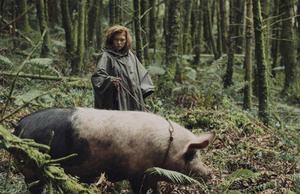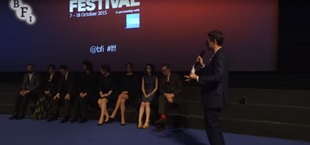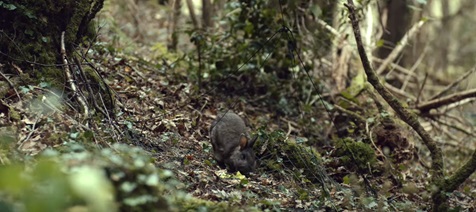
The Lobster is a modern parable in which societal norms are completely called into question by absurdity of form. In the not too distant, or not too past, world of The Lobster, single people are sent to a hotel in which they must find a mate in 45 days or otherwise be turned into an animal of their choice. David, our protagonist, chooses – you guessed it – a lobster, mainly because “they live for a hundred years” and “are blue blooded like aristocrats”[1]. What follows this thoroughly bizarre but totally unquestioned certainty, with David’s reticent shrewdness in the hotel and in the face of romantic doom, is a story of touching romance. In addition to this is the ever-present threat of animality or death hanging over life. However, we come to see that in this world, there are characters with a strong enough will to defy these strict conventions.
Surreal humour is described as “not able to occur, exist, or be done” and absurdist humour is “deserving or inviting derision or mockery”[2]. The Lobster could very well be described as possessing both of these characteristics. The filmfully embraces Surrealism in the sense that it takes vital facets of humanity – such as companionship, rebellion and compliance – and subverts their societal implications, whilst still containing enough recognisable aspects of civilisation to present a life not too dissimilar from our own, “stripped down to its essence”[3]. For example, within the film, rebellion (a concept defined as “determined defiance of or resistance to any author, controlling power, or convention”[4]) is ironically just as regimented and stifled as the constriction-laded life within society and the hotel.
In conjunction with this slightly confused narrative and generic impetus, Surrealism stands to make mockery of everything we also question unknowingly and without confusion. By making association in its title with perhaps the pinnacle of Surrealist artistic expression (in Dali and his near-obsession with the lobster and its psychosexual properties, especially seen in ‘Lobster Telephone – 1936’, below), Lanthimos’ film is unquestionably placed within the Surrealist generic lexicon.

Lobster Telephone – Salvador Dali (1936)
Within this surreal yet accepted narrative construction, the majority of the characters in the film function unquestioningly within the confinements of a society which threatens to transform them into the animal unless superficial pressurised ‘love’ is conceded to. The outcasts live in fear of this same animal fate, or death and abandonment, without the consolation of companionship; it is, in fact, punished with ‘the red kiss’, a violent condemnation of physical intimacy. A dichotomy soon emerges between the film’s obvious critique of romantic love and coupledom, and the film’s core narrative being generically romantic in David and Short Sighted Woman’s relationship.

Screenshot from a BFI Q&A in which Colin Farrell answers the question “do you think The Lobster is a romantic film?” with “I do, because romance to ever have full expression of itself has to defy the odds”
Alongside the dichotomies between death and the animal, companionship and loneliness, there is also one between absence and presence. Throughout the film, animal impact is defined by its poignant absences within the film. The death and consequent absence of David’s brother (also his pet dog), sets in motion the narrative that moves us towards the romance that springs from David’s rebellion in leaving the societal system. The animal is used mainly as a narrative device that intimidates and scares the characters into submission. Many characters repeatedly use the phrase “didn’t make it”[5] as a sort of euphemism for someone having to become an animal. This animal state is evidently one that nobody wants to reach, so in ‘not making it’, the absence of the animal being mentioned comes in the negative space inherent in the clause. The animal becomes an unmentionable and unwanted thing. In making the animal taboo, Lanthimos creates an even wider divide between the human and animal dichotomy present. Yes, the characters will eventually achieve unwilling symbiosis with the animal, but do everything in their power not to.
Human to animal transfiguration is a core anxiety of The Lobster’s essence. In a key scene, David’s brother, who is now to all intents and purposes his docile pet dog, is brutally killed by David’s completely heartless would-be partner. She has killed the dog in order to provoke a reaction that proves that David is not heartless, and is therefore not her ideal mate. The surreal – his brother being a dog, for one – is intensified by the stifling of emotions one should feel on the murder of a family member. The manner in which she informs David of what she has done is full of stillness and menace – “I killed your brother. I left him to die slowly”[6]. She makes no mention of his animal state, which makes the brutality of murder all the more shocking – because she kills not in spite of this animality, but rather ignores it altogether. Here, the impact of death becomes simultaneously lessened because the animal cannot vocalise its pain linguistically, and heightened because the brother became animal only to have been put to death for his human, fraternal link to David. After the act, the Heartless Woman then proceeds to mimic the whimper he made as he died, which of course raises the surreal nature of the sombre murder confession to new heights. This shifts to a shockingly visual representation of the animality she initially denies David’s brother. The shot lingers on the image of the grievously injured dog – the lighting is stark, there is no music. We are shocked because we are forced to look at the results of the violent act towards the animal. To be made animal rids the brother in question of an autonomous voice within a film so preoccupied with the voice, and the silence in this shot emphasises this. The dichotomy of animality and lingering humanity within The Lobster can perhaps be best explained through the critical study of what brings us as animals and humans together, and what marks us as different.
The “limitrophy”[7] between the animal and the human is blurred constantly throughout The Lobster. What Derrida defines as “what […] grows at the limit, around the limit, by maintaining the limit […] what feeds the limit, generates it, raises it, and complicates it”[8] is integral to the reading of The Lobster as an exploration of animality and Surrealism. The act of obscuring the limit, most notably observed in scenes which human characters continue to refer to their animal-transformed friends as if they were engaging in one side of a two sided conversation, is brought to surreal heights by Lanthimos’ direction. Deadpan humour, a notable feature of Surrealism, arises from a scene in which Nosebleed Girl says her goodbyes to her best friend, and then continues on to stroke her mane. The Lobster contains both humour and pathos in the way it treats the limitrophy of animal and human relations that ultimately cannot converge through concepts of friendship, family and otherness.
Continuing on from the othering act of canicide, The Lobster becomes increasingly about choice. Directly after her confession, David takes it upon himself to do away with Heartless Woman. He achieves this by taking her to the animal transformation room and giving her the fate they are all so desperately trying to escape – the wordless animal. When Heartless Woman realises that David has lied to her, he asks “What is the punishment for this?” to which she replies “They turn you into the animal that no-one wants to be”[9].

David, taking Heartless Woman into the Transformation Room, presumably to turn her into “the animal that no-one wants to be” (The Lobster, dir. by Yorgos Lanthimos)
This acts as a vocal foreshadowing to her eventual transformation. We can assume that, because he does not divulge it to Short Sighted Woman (he says it is “none of [her] concern”[10]), that he has chosen the most serious punishment for Heartless Woman. This pointed exclusion leads the audience to ponder just what makes one animal ‘worse’ or less desirable in its being than another. Lanthimos morally provokes us into considering the animal hierarchy – what animals come before others – and our belief that we would fall from the top to the bottom of the hierarchy through transformation from human to animal. This hierarchy arguably becomes indicative of our own self-inflicted societal hierarchy. The classes, as they rise, are aspirational; one arguably aims to ascend from the lower classes. However, these boundaries, the upper and lower classes so distinctly split apart from each other in wealth, are very rarely traversed. The human and animal hierarchy that is similarly enforced within The Lobster, and the moral implications of crossing the boundaries it creates, are deftly consolidated in a scene in which a character describes his transgression of this boundary. The fact it is not successful but very dangerous, is indicative of The Lobster’s wider societal disapproval of disobedience of its own set rules.
This touching, and darkly humourous scene in the film, explores the emotional bonds we forge between our own species and others, and the distinction between these, before displaying both as essentially dangerous. Limping Man addresses the room. His mother was turned into a wolf and taken to a zoo, and he routinely fed all of the wolves because he wasn’t sure which one was his mother. One day, he goes into the enclosure because he “wanted a hug”[11] – completely ridiculous, ultimately, but Limping Man is following his human compulsion for closeness to his mother and ignores the ramifications of the change from human to animal – and is attacked by the wolves. That is, all but two. He assumes, projecting his feelings of human intimacy onto wild animals, that one of those contained the spirit (or brain, or eyes, or other human organ) of his mother. Within the absurd structure of the film, it is not entirely impossible that this was fact. However, the seriousness of his admission of desperation for compassion in wildness, provokes a recognition of the ridiculous in the film’s audience. The crux of the story arguably gives it its absurd and saddening resolution; because two wolves abstained, Limping Man still does not achieve his desire for familial intimacy – he can never know which one was his mother. Additionally, in the (off-screen) suggestion of violence, Lanthimos warns of the dangers of projecting human attributes and feelings onto animals, and as the physical danger Limping Man put himself in becomes his defining feature, the animal has indelibly altered him. The absence of love and family, and the subsequent search for both, has provoked Limping Man into absurd action.
The film is arguably characterised by variations on animal death and loss. Only in passing do we see animals that thrive or simply exist (a camel and a peacock, very probably the failed offshoots of the hotel’s coupling attempts, wander the forest); the animals that are integral to the plot of the film are only integral in their death. As stated before, David’s dog/brother is killed and the film’s narrative action is instigated. Along with this, the central relationship between David and Short Sighted Woman is established through a bizarre foreplay that includes David catching and delivering dead rabbits for her to eat. These characters, that have in common simply their need for visual aid, find kinship in the flagrant disregard for animal life. Their actions – whilst bizarrely touching and primitive in the context – are indicative of the mindset that animality is equated with the level of functionality of death (that is, no functionality at all) within the film. The inability to sympathise or relate to the human-turned-animal outside of the context of human friendship, results in an absurdly cold relation to the animal as either a commodity or useless. This speaks to the way in which the characters envision their prospective lives outside of a couple and in animal, as a fate akin to death – a character called Biscuit Woman attempts suicide because she is so sure in this conviction.

Rabbit in process of capture by David, with intent to kill and present to Short Sighted Woman, (The Lobster, dir. by Yorgos Lanthimos)
In Lanthimos’ earlier film, Dogtooth, the thematic through-line of animal as an intimidating and restrictive presence is also evident. In that film, the family are constricted to the familial domicile as the characters of The Lobster are to the societal one. Most notably, the cat is placed as a substitute captor for the parents (who actually detain the children by choice). The father states that “The animal that threatens us is a “cat”. The most dangerous animal there is […] after lacerating its victim with its claws, it devours them with sharp teeth.”[12] Here the animal is made beastly in order to frighten and intimidate – it acts precisely as the threat of transformation for the single person does in The Lobster. In both, the animal is intrinsically interwoven with death. If we were to take the nihilistic view that we all die alone, we would, in the world of The Lobster, also have to concede that we all die an animal.
[1] The Lobster, dir. by Yorgos Lanthimos (Picturehouse Entertainment, 2015, UK)
[2] Williams, Danae, ‘Absurdist Humour vs. Surreal Humour’, (11th February 2015), http://www.danaewilliams.com/blog/absurdist-versus-surreal/
[3] Han, Angie, ‘Yorgos Lanthimos’ ‘The Lobster’ Is a Spiky Satire of Modern Romance’, Slash Film, (1st October 2015), http://www.slashfilm.com/the-lobster-review/
[4] Rebellion, noun. 2.a, http://www.oed.com/view/Entry/159201?rskey=nzgZXu&result=1#eid
[5] The Lobster, dir. by Yorgos Lanthimos
[6] The Lobster, dir. by Yorgos Lanthimos
[7] Derrida, Jacques, ‘The Animal That Therefore I Am’, trans. by David Wills, Critical Enquiry, Vol. 28, No. 2, (University of Chicago Press, USA, 2002), pp. 397
[8] Derrida, Jacques (2008). David Wills, trans., Marie-Louise Mallet, ed. The Animal that Therefore I Am. New York: Fordham UP. pp. 29–30
[9] The Lobster, dir. by Yorgos Lanthimos
[10] The Lobster, dir. by Yorgos Lanthimos
[11] The Lobster, dir. by Yorgos Lanthimos
[12] Dogtooth, dir. by Yorgos Lanthimos, (Boo Productions, 2009, Greece)
Suggestions for further reading:
- Derrida, Jacques, ‘The Animal That Therefore I Am’, trans. by David Wills, Critical Enquiry, Vol. 28, No. 2, (University of Chicago Press, USA, 2002)
- Higgs, Christopher, ‘Notes on Derrida’s The Animal That Therefore I Am’, (February 26th 2010), [accessed 23rd November 2015]
- Kermode, Mark, ‘Mark Kermode reviews The Lobster’, https://www.youtube.com/watch?v=e1VyXx7GiAo, [accessed 16th November 2015]
- Koster, Alexandra, ‘Film Review: The Lobster’, The Iris, (October 18th 2015), http://iris.theaureview.com/film-review-the-lobster-uk-2015/, [accessed 16th November 2015]
- Williams, Linda, Figures of Desire: A Theory and Analysis of Surrealist Film, (University of California Press, USA, 1992)
- Gavins, Joanna, Reading The Absurd, (Edinburgh University Press, UK, 2013)
Bibliography:
- Film 4, ‘The Lobster | Trailer | Film4’, (3rd September 2015), https://www.youtube.com/watch?v=fpt0tn1-54k, [accessed 16th November 2015]
- BFI, ‘The Lobster Q&A with Rachel Weisz and Colin Farrell | BFI’, (14th October 2015), https://www.youtube.com/watch?v=Iq80nvxHI44, [accessed 17th November 2015]
- Dali, Salvador, Lobster Telephone (1936), http://www.tate.org.uk/art/artworks/dali-lobster-telephone-t03257, [accessed 24th November 2015]
- Derrida, Jacques, ‘The Animal That Therefore I Am’, trans. by David Wills, Critical Enquiry, Vol. 28, No. 2, (University of Chicago Press, USA, 2002)
- Dogtooth, dir. by Yorgos Lanthimos, (Boo Productions, 2009, Greece)
- The Lobster, dir. by Yorgos Lanthimos (Picturehouse Entertainment, 2015, UK)
- Han, Angie, ‘Yorgos Lanthimos’ ‘The Lobster’ Is a Spiky Satire of Modern Romance’, Slash Film, (1st October 2015), http://www.slashfilm.com/the-lobster-review/, [accessed 16th November 2015]
- Williams, Danae, ‘Absurdist Humour vs. Surreal Humour’, (11th February 2015), http://www.danaewilliams.com/blog/absurdist-versus-surreal/, [accessed 16th November 2015]